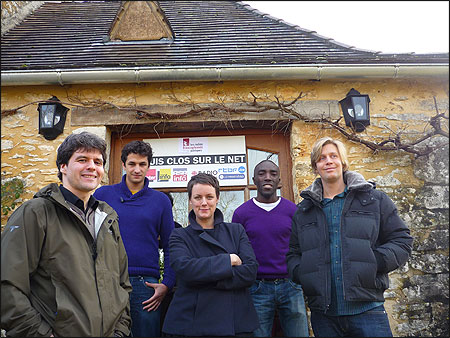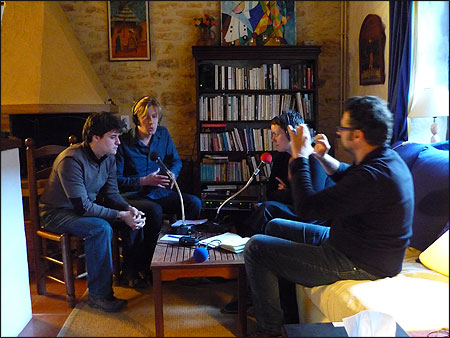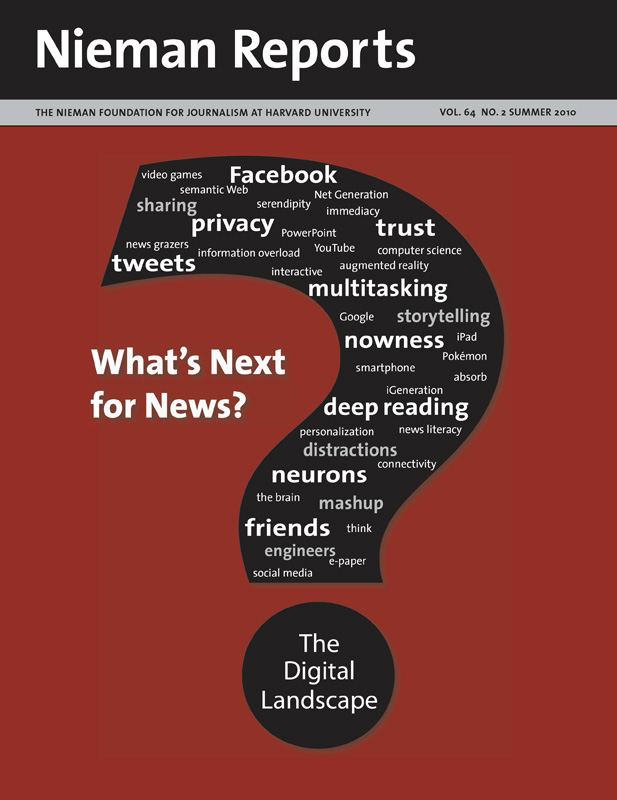
Janic Tremblay, left, and four other journalists from French-speaking public radio stations spent five days in a cabin in southern France. Their goal was to keep informed using only social networks. The project was called “Huis Clos Sur Le Net,” which roughly translates to “Behind Closed Doors on the Net.” Photo by Nicolas Mathias.
In February, five journalists from French-speaking public radio stations isolated themselves in a farmhouse in southern France to conduct an experiment. For five days they would stay informed by using only their social networks. Their ground rules forbid them to follow the feeds and tweets of any news media; to be informed, they had to rely solely on the tweets or Facebook offerings of individuals or organizations such as nonprofits, government agencies, or educational institutions. One of the secluded journalists was reporter Janic Tremblay, who works at Radio-Canada. In this article, he describes the experience and the lessons he brought back to his work.
Listen to an NPR interview with Tremblay »“News will find you wherever you are.” That’s what a lot of people think now that the Internet is in its third revolution—as the always on, always available Web. Thanks to Facebook, Twitter and the smartphone, we expect that we will be informed in real time on just about any topic. We depend on family members, close friends, and those who are part of our digital networks to act as reporters, alerting us when something they feel is important has happened or is happening. Within our chosen digital community, we are always connected, always informed. At least, that’s how the story goes.
But is this how it actually happens? What kinds of information emerge through social networks? What do people talk about after traditional news media sources have been removed? Which news do they tweet? Or retweet? And do social networks help us find valuable information?
We humbly set out with these questions—and others—in mind, hoping we’d find a way to measure, though not in any scientific way, the value our social networks held for us as journalists. We set some rules, locked the door of our home in Saint-Cyprien, and turned our full attention to the Web. From there, many lessons—most discovered through Twitter—flowed my way:
- Twitter can be like radar: On our first night in France, I went online and came across tweets from a man who had been arrested during a demonstration in Moscow earlier that day. He had been jailed for many hours and was tweeting about what was happening. I did not know him. Clearly we lived in different universes, but it turned out that a member of his social network is also part of mine. When my social networking friend retweeted his posts, he showed up in my Twitter feed, and there we were—connected, with me in a French farmhouse and he in jail in Moscow. And so I tweeted him directly, then later contacted him by phone. He spoke French very well, an important detail for a French-speaking radio reporter. He told me about his arrest and the condition of his detention, and so I had a good story. With the traditional tools of journalists, the odds of me finding this man would have been close to zero. However, I believe situations like this one happen rarely, as best I can tell from my experience and that of my colleagues.
- Twitter can steer off course: It was the third night of our stay in Saint-Cyprien. Apparently a very loud noise had been heard in the city of Lille in northern France. Lots of tweets talked about this noise. It was obvious that people were trying to figure out what had happened as this topic became the talk of the French Twitter-sphere that night. Many hypotheses were tweeted; it was an explosion, a fire, or maybe a nuclear problem. In the next day’s newspaper (which I could not read at the time), a reporter unraveled the mystery with a story of what actually happened. The loud sound was from an airplane that had crossed the sound barrier over the city. On Twitter, I had not seen anyone come up with this explanation. So while we knew what was being talked about via the tweets, we had no idea what was happening.
- What I like about you is me: Like all social media networks, the Twitter experience is determined by those whose tweets we welcome into our digital feed. And digital communities tend to congregate around interests or issues. This isn’t so very different from how audiences flock to various news media (Fox News or CNN, for example) based on the topics or perspective they are fairly certain they’ll find there. It can feel reassuring to follow like-minded people. Who doesn’t like to have their opinions confirmed? Yet choosing such a specific path to news can also be limiting since it can be hard to count on friends to broaden our horizons. Like a couple who thinks alike, neither brings much new to their conversation or thinking.
Tweeting Lessons
As I think back on these five days—and what I learned, I focus on the social networks I brought with me into our house. This experience taught me that they were not diversified enough. News reached me, but in my mix of tweets I could find little in-depth analysis or many international news reports. Nor did I find much discussion about news taking place among members of my network. And only very rarely did I hear much about economic news.
I came to understand that there is a science to this quest for creating the right network. It’s an empirical process, one that requires lots of time and thought and effort. And the search for the best sources of news never ends. I also concluded from this experience that finding symphonic notes amid all the noise of these networks is not easy. Moreover, on Twitter, people tend to tweet what they have picked up from the traditional news media; what they add is an introduction to what they’ve found, letting their friends or followers know that they found it interesting or new, moving or fascinating. Right now how this exchange of information happens is very tied in with the tools of social media that we have available to us, and this is something else we experienced firsthand during our week in France.
One lesson I took from this experience is that what interests the public—as I saw interest expressed by what they share and highlight through these social media networks—is not the same as the public interest, at least as journalists conceive of it. Of course, these two ideas might grow closer in time as Twitter becomes more popular.

Journalists broadcast from the cabin where they spent five days without direct access to news media. Janic Tremblay is at left. Photo by Nicolas Mathias.
Getting Personal
While in the farmhouse, I managed to gather almost all of the important news during the more than 60 hours that I spent on Twitter. (After we emerged, I checked to see what stories I might have missed.) Retweets turned out to be essential for my newsgathering since I was not allowed to follow any media organizations. But being constrained, as I was, helped me realize how often messages that journalists send out are retweeted. On the other hand, the stories sent out by newspapers and broadcast entities didn’t get retweeted too much. What this told me is that there is a strong tug of personal engagement within the digital community, evidenced as members of the community retweet stories that are brought to the Twitter feed by an author or journalist himself.
At CBC/Radio-Canada where I work, very few journalists use Twitter. Even so our news organization has a Twitter account with more than 30,000 followers. However, during the five days of the experiment, I did not find any news from Radio-Canada. The reason: no retweets. A popular French-Canadian newspaper, La Presse, also has a Twitter account with just about the same number of followers, and I did not get any retweets from La Presse’s feed, either. But many journalists at La Presse tweet personally, so many of their stories made their way to me through retweets.
The lesson is simple: journalists should tweet about their stories. By doing so, they might get a higher penetration rate of clicking on links and sharing among followers; they will also likely gather new followers through this retweeting, and ultimately getting the news out will inform more people, which is our goal.
But there are other key considerations about why more journalists tweeting is better than fewer. When only a few journalists tweet—and do so constantly—they occupy a lot of the space. This means that their perspective on the news could become the dominant (or possibly the only) interpretation of an event and, if this happens, the lack of diversity of the information becomes an important issue.
Social Media and Journalism
While social media networks can be a personalized resource for news, it is virtually impossible to work eight hours a day, take care of the kids, regularly ride the train to work and back, read books and articles, follow what hundreds of people are tweeting at the same time, and click on the links they suggest and end up absorbing anything fully. Even with a deliberate focus on doing so, as we had for those five days in the absence of any distractions, this was hard.
This is one reason why I so firmly believe that traditional news media outlets are still essential—as the people who can provide reliable journalistic content, which then forms the backbone of Twitter’s links. This is not to say that any others who can bring additional knowledge and information into the mix shouldn’t do so. They should, but having this foundation built by the practitioners of journalism’s standards and ethics is vital.
Still, it now is not possible for journalists to ignore or neglect Twitter. Too much is happening there. Every individual journalist—along with every news organization—should put strategies in place to determine the best ways to do our work in tandem with the culture and habits of social media networks. Also, figuring out how best to thrive in the Twitter environment without compromising our work as journalists (and not as advocates) is part of what the job entails today. Tweets are easily sent and they leave traces for a long time—just as all words and pictures do in this digital territory. When personal opinion reigns supreme—with a side taken and a perception settling in—then serving the public interest as a journalist just got harder to do.



